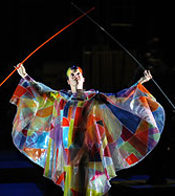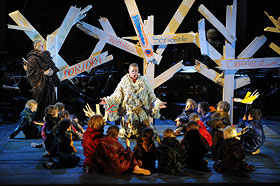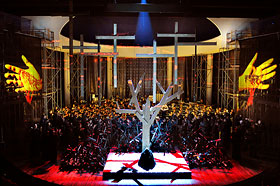
09 Jun 2008
St. Francis in Amsterdam
It is a bit hard to know what to make of Olivier Messiaen’s colossal piece “Saint François d’Assise,” beautifully mounted by Netherlands Opera.
English Touring Opera are delighted to announce a season of lyric monodramas to tour nationally from October to December. The season features music for solo singer and piano by Argento, Britten, Tippett and Shostakovich with a bold and inventive approach to making opera during social distancing.
This tenth of ten Live from London concerts was in fact a recorded live performance from California. It was no less enjoyable for that, and it was also uplifting to learn that this wasn’t in fact the ‘last’ LfL event that we will be able to enjoy, courtesy of VOCES8 and their fellow vocal ensembles (more below …).
Ever since Wigmore Hall announced their superb series of autumn concerts, all streamed live and available free of charge, I’d been looking forward to this song recital by Ian Bostridge and Imogen Cooper.
Although Stile Antico’s programme article for their Live from London recital introduced their selection from the many treasures of the English Renaissance in the context of the theological debates and upheavals of the Tudor and Elizabethan years, their performance was more evocative of private chamber music than of public liturgy.
Evidently, face masks don’t stifle appreciative “Bravo!”s. And, reducing audience numbers doesn’t lower the volume of such acclamations. For, the audience at Wigmore Hall gave soprano Elizabeth Llewellyn and pianist Simon Lepper a greatly deserved warm reception and hearty response following this lunchtime recital of late-Romantic song.
For this week’s Live from London vocal recital we moved from the home of VOCES8, St Anne and St Agnes in the City of London, to Kings Place, where The Sixteen - who have been associate artists at the venue for some time - presented a programme of music and words bound together by the theme of ‘reflection’.
'Such is your divine Disposation that both you excellently understand, and royally entertaine the Exercise of Musicke.’
‘And there was war in heaven: Michael and his angels fought against the dragon; and the dragon fought and his angels, And prevailed not; neither was their place found any more in heaven … that old serpent … Satan, which deceiveth the whole world: he was cast out into the earth, and his angels were cast out with him.’
There was never any doubt that the fifth of the twelve Met Stars Live in Concert broadcasts was going to be a palpably intense and vivid event, as well as a musically stunning and theatrically enervating experience.
‘Love’ was the theme for this Live from London performance by Apollo5. Given the complexity and diversity of that human emotion, and Apollo5’s reputation for versatility and diverse repertoire, ranging from Renaissance choral music to jazz, from contemporary classical works to popular song, it was no surprise that their programme spanned 500 years and several musical styles.
The Academy of St Martin in the Fields have titled their autumn series of eight concerts - which are taking place at 5pm and 7.30pm on two Saturdays each month at their home venue in Trafalgar Square, and being filmed for streaming the following Thursday - ‘re:connect’.
The London Symphony Orchestra opened their Autumn 2020 season with a homage to Oliver Knussen, who died at the age of 66 in July 2018. The programme traced a national musical lineage through the twentieth century, from Britten to Knussen, on to Mark-Anthony Turnage, and entwining the LSO and Rattle too.
With the Live from London digital vocal festival entering the second half of the series, the festival’s host, VOCES8, returned to their home at St Annes and St Agnes in the City of London to present a sequence of ‘Choral Dances’ - vocal music inspired by dance, embracing diverse genres from the Renaissance madrigal to swing jazz.
Just a few unison string wriggles from the opening of Mozart’s overture to Le nozze di Figaro are enough to make any opera-lover perch on the edge of their seat, in excited anticipation of the drama in music to come, so there could be no other curtain-raiser for this Gala Concert at the Royal Opera House, the latest instalment from ‘their House’ to ‘our houses’.
"Before the ending of the day, creator of all things, we pray that, with your accustomed mercy, you may watch over us."
The doors at The Metropolitan Opera will not open to live audiences until 2021 at the earliest, and the likelihood of normal operatic life resuming in cities around the world looks but a distant dream at present. But, while we may not be invited from our homes into the opera house for some time yet, with its free daily screenings of past productions and its pay-per-view Met Stars Live in Concert series, the Met continues to bring opera into our homes.
Music-making at this year’s Grange Festival Opera may have fallen silent in June and July, but the country house and extensive grounds of The Grange provided an ideal setting for a weekend of twelve specially conceived ‘promenade’ performances encompassing music and dance.
There’s a “slide of harmony” and “all the bones leave your body at that moment and you collapse to the floor, it’s so extraordinary.”
“Music for a while, shall all your cares beguile.”
The hum of bees rising from myriad scented blooms; gentle strains of birdsong; the cheerful chatter of picnickers beside a still lake; decorous thwacks of leather on willow; song and music floating through the warm evening air.

It is a bit hard to know what to make of Olivier Messiaen’s colossal piece “Saint François d’Assise,” beautifully mounted by Netherlands Opera.
Nearly everything about the writing seems over the top. Its incredible length. Its massive orchestral forces. Its sanctimonious religious posturings. All seems calculated not just to merely impress or to move, but to wallop you over the head with some quasi-spiritual revelation.
In assessing the stage worthiness of lyric theatre pieces, Joseph Kernan wrote “the best operas are dramatic, the failures are no proof at all.” Let’s just say that “Saint François” is to my taste, well, not dramatic. Most everything about it resembled a cleverly staged oratorio. To that end, the gigantic orchestra was placed on stage (it probably wouldn’t fit in the pit!). Scaffolding and ramps and a huge balcony are built around the band, intentionally including it in the stage picture.
That leaves the simple story to play out on the huge apron in front of it which covered the unused pit. And the dramatic content of that story goes something like this: Saint counsels fearful monks. Saint heals leper. Saint talks to birds. Saint receives stigmata. And dies.
Oh, yeah, and a busybody angel visits and spooks the bejesus out of the scaredy-cat monks. I joke — slightly — but this thin plot is stretched out of all proportion into well over five hours. What almost energizes and sustains the story-telling is the masterful stagecraft of designer Jean Kalman and director Pierre Audi, for they have devised some beautifully evocative effects.
Act One finds a pile of simple (mostly black) wooden crosses center stage, a lone bench, and a “reveal” of a pulpit on an elevated platform. As other crosses are added to the pile, the imagery suggested so many possibilities. Do they represent of martyrs’ bodies? A pyre created by religious fanaticism? Holocaust victims? It raised expectations (unfulfilled, alas) that the piece might have something to say beyond presenting a public face of the composer’s private, deeply felt Catholicism.
Although that imagery was never fully developed, Act Two’s stylized rolling trees made of bare planks always reminded us that the cross of Christ was in fact made from a tree, and the slightly raked black platform center stage allowed for some beautiful artistic groupings which were put into fine dramatic relief against the ground cloth. In Act Three, the crosses were piled up in a semi-circle at the base of a lone rude tree, like so much concertina wire forming a base of thorns. The simple small wooden platform in front of this was a perfect focus for “François’” last moments.
Audi is a master at slowly building visual tension; and delving deep into characters’ souls to devise complex relationships, varied stage movement, and evolving pictures of complete inevitability. He did his level best to wring every last viable possibility out of the repetitive moments of the repetitive moments of the repetitive moments of the . . .stop me!
 The well-crafted straight forward confrontation between “Saint
François” and the “Leper” fairly crackled. A wonderfully tender
relationship was developed between “François” and the fearful
“Léon,” which seethed with subtext. “The Angel’s” every scene had
a haunting visual beauty and meaningful interaction, with excellent use of
levels for psychological impact.
The well-crafted straight forward confrontation between “Saint
François” and the “Leper” fairly crackled. A wonderfully tender
relationship was developed between “François” and the fearful
“Léon,” which seethed with subtext. “The Angel’s” every scene had
a haunting visual beauty and meaningful interaction, with excellent use of
levels for psychological impact.
That said, even Mr. Audi and his design team could not salvage the interminable final scene of Act Two with the children and the birds. Long after we got the point, and got it again, like the Energizer Bunny it went on and on and on. Oh, they made a good stab at maintaining our interest with some playful writing of the birds’ names on the bare trees with Magic Marker, and the genial waving about of colorful paper birds. But long after the Marker was dry and arms were dead tired of bird-play, it kept churning, not in a mesmerizing Phillip Glass sort of way, just. ..churning in fits and starts.
Critically, it seemed that “François’” death went for too little. Perhaps we waited too long for it? Or perhaps a better visual solution could have been found other than having the dead man file off between the choristers. Although the lighting was excellent throughout, the script says the final lighting effect should glow blindingly brighter where “François” had lain. Instead, a truncated bank of orange lights glared from behind the upstage scrim like back lighting left over from the Vegas scene of “Dreamgirls.”
Happily, Netherlands Opera’s reliably high quality visuals were matched by a truly wonderful cast. Camilla Tilling’s engaging “Angel” walked off with the show and it is easy to see why. She is possessed of a clear, lovely soprano with plenty of point in all registers. She sings the role with great understanding, masterful phrasing, and complete control of the musical challenges. And, she quite simply has the most beautiful and accessible music in the piece, which she serves very well.
Hubert Delamboye has only once scene as “The Leper” but he wrung every ounce out of it with fiery, securely voiced declamation. The effect of his being cured was magically created by his simply peeling off one of his garish gold and black sleeves to reveal his pure flesh unadorned. Both baritone Henk Neven (“Frére Léon”) and tenor Tom Randle (“Frére Massée”) turned in performances that could not be bettered. In a piece of luxury casting, heroic leading tenor Donald Kaasch sang a fine “Frére Elie.” Armand Arapian, Jan Willem Baljet, and Andre Morsch contributed solid singing in their smaller parts. The excellent chorus was tremendous in their powerful, meticulously schooled phrasing.
 That leaves our “Saint François.” Although he was not announced as
indisposed, popular baritone Rod Gilfry seemed at times like he might have
been a little tired in this first performance after the premiere. He is a
fine singer (as well as actor) and he certainly commands a secure technique.
But this role is a huge step forward from his core repertoire of
“Dulcamara” and “Marcello” and “Papageno.” The rangey writing for
a dramatic baritone (or high bass) who seldom leaves the stage, calls on
every trick in the singer’s bag. I commend Mr. Gilfry for the considerable
success he has had with this assumption, and the fact that he has learned
this demanding part speaks well for him as a serious artist.
That leaves our “Saint François.” Although he was not announced as
indisposed, popular baritone Rod Gilfry seemed at times like he might have
been a little tired in this first performance after the premiere. He is a
fine singer (as well as actor) and he certainly commands a secure technique.
But this role is a huge step forward from his core repertoire of
“Dulcamara” and “Marcello” and “Papageno.” The rangey writing for
a dramatic baritone (or high bass) who seldom leaves the stage, calls on
every trick in the singer’s bag. I commend Mr. Gilfry for the considerable
success he has had with this assumption, and the fact that he has learned
this demanding part speaks well for him as a serious artist.
Indeed, he always displayed utter commitment and total concentration, and lavished us with beautiful outpouring of sound. But it did push him to the limit. For all his success with it, I wonder if he might not retire the role from his repertoire for a few years until age provides a bit more heft and stamina? With his chiseled good looks and designer white robe, he did not look the ascetic monk so much as a very caring fashion model (is there such a thing?) before a Prada ad shoot. Other than that, I found Angelo Figus’ costumes highly creative and character-specific. The “Angel’s” several apparitions were beautifully attired, especially her knock-out plastic gown that looked like a Kandinsky had collided with a shower curtain. No kidding. Wild and wonderful!
It is hard to over-praise Ingo Metzmacher and his superb Resident Orchestra for their thrilling reading of this gigantic score. Their attention, concentration and musicality never flagged over an exceedingly long evening. For all my reservations about the dramatic viability of the piece, there is some remarkable writing in it. All of the “Angel’s” scenes, including her motif are ravishing; the “Leper” is well characterized; the choral writing is compelling; and “François’” solo and duet scenes with “Léon” and “Massée” contain many serenely beautiful musical themes and haunting melodies.
But that jittery wind section repeats about ten times too often, and what seem to be logical musical climaxes simply frustrate us by morphing into another repetitive section, or more jittery winds. To me, it seemed that Messiaen the Catholic sometimes indulgently eclipsed Messiaen the musical crafts smith.
Is “Saint François d’Assise” a viable opera? Kernan be damned, Netherlands Opera thinks it is. And they are to be congratulated for coming to grips with it with well-considered solutions, and for treating us to a thoroughly engaging and uncompromisingly professional production.
James Sohre